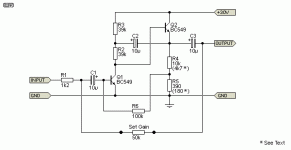Hello, everyone!
I am making a simple DIYMic Pre but have run into with adding phantom power.
The pre is unbalanced but the mic coming in is balanced.
I know that phantom goes into XLR 2 and 3 via resistor, but only pin goes to the circuit input.
What should I do with pin 3?
Schematic:
I am making a simple DIYMic Pre but have run into with adding phantom power.
The pre is unbalanced but the mic coming in is balanced.
I know that phantom goes into XLR 2 and 3 via resistor, but only pin goes to the circuit input.
What should I do with pin 3?
Schematic:
Attachments
100% of all involved (balanced input) cicuits in mixing desks are phantom powered on both pins 2 & 3.
It's about condenser type mics - your circuit is for (ahum) cheap 'humming along' mics...
It might work, don't expect miracles. One leg less is a loss of 6dB already.
So the fader goes up, and the noise too.
It's about condenser type mics - your circuit is for (ahum) cheap 'humming along' mics...
It might work, don't expect miracles. One leg less is a loss of 6dB already.
So the fader goes up, and the noise too.
You need a differential preamp circuit for studio condenser mics, 48V phantom power to both sides via 6k8 resistors. And a widely variable gain is essential too for any mic preamp... I found one of Bob Cordell's designs as an example:
https://www.cordellaudio.com/preamplifiers/dynamicmicpreamp.shtml
Which microphones are you intending to use? Not all require a full 48V.
https://www.cordellaudio.com/preamplifiers/dynamicmicpreamp.shtml
Which microphones are you intending to use? Not all require a full 48V.
